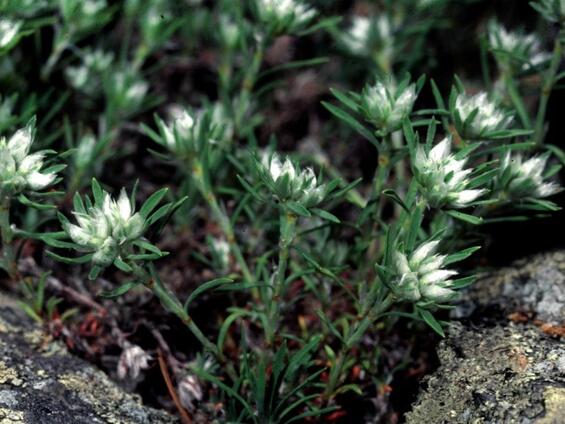- Scientific name: Paronychia argyrocoma
- Species of Greatest Conservation Need (MA State Wildlife Action Plan)
- Endangered (MA Endangered Species Act)
Description

Silverling (Paronychia argyrocoma)
Silverling is a low-growing perennial in the Carnation family (Caryophyllaceae) that forms broad tufts. The plant rises from a slender tap-root, and the 5-30 cm (2-12 in) long, silky-hairy stems branch repeatedly at its base, giving the plant its tufted appearance. Although silverling generally grows singly or in small groups, it may occasionally grow in colonies. Its narrow, opposite leaves reach from 1-3 cm (0.4-1.2 in) in length and may either be hairless or covered in silky hairs. In addition, the leaves have a pair of narrow stipules (vegetative appendages located where the leaves join the stem). Silverling’s small flowers occur in dense, terminal, silvery clusters. Each blossom has five hairy sepals (members of the lowermost floral whorl) and petals that are greatly reduced and inconspicuous. The flowers are obscured by the thin, silvery bracts (modified leaves associated with flowers). Silverling blooms from July through August. Its fruit is a capsule (a fruit, containing many seeds, derived from a compound pistil).
Two other species of the genus Paronychia grow in Massachusetts: forked chickweed (P. canadensis) and hairy forked chickweed (P. fastigiata). However, both grow in habitats different from those of silverling; furthermore, their stems are not branched at the base.
Life cycle and behavior
This is a perennial species.

Population status
Silverling is currently listed as Endangered in Massachusetts. There is a severe lack of suitable habitat for silverling in the Commonwealth. Silverling is also considered rare in Maine, New Hampshire, West Virginia, North Carolina, Georgia, Kentucky, and Tennessee. The Natural Heritage & Endangered Species Program has 1 record from 1 county: Essex. This record has been observed within the last 25 years.
Distribution and abundance
The documented range of silverling includes Maine, New Hampshire, and Massachusetts, and extends south to Virginia, West Virginia, North Carolina, Kentucky, Tennessee, and Georgia.

Distribution in Massachusetts. 2000-2025. Based on records in the Natural Heritage Database.
Habitat
In general, silverling grows in open areas in the crevices of granitic rock slopes and ledges and on gravelly soils that are poor in organic matter, usually at mid to upper elevations in mountains. The sole Massachusetts site, a granite riverine island, is unique. Here, silverling grows in the crevices and crags of granite ledges situated above the high tide mark. It appears likely that this colony was established by seeds that floated down the Merrimack River. Among the tree species associated with silverling here are eastern red cedar (Juniperus virginiana), pitch pine (Pinus rigida), white pine (Pinus strobus), black cherry (Prunus serotina), gray birch (Betula populifolia), and various oaks (Quercus spp.). Other plant associates include black huckleberry (Gaylussacia baccata), crinkled hairgrass (Deschampsia flexuosa), pineweed (Hypericum gentianoides), sheep fescue (Festuca ovina), poison ivy (Toxicodendron radicans), and various mosses (Polytrichum spp.) and lichens.
Healthy habitats are vital for supporting native wildlife and plants. Explore habitats and learn about conservation and restoration in Massachusetts.
Threats
Threats to the species include heavy foot traffic and, at least in New England, its small population sizes and very restricted and local ranges.
Contact
| Date published: | May 1, 2025 |
|---|